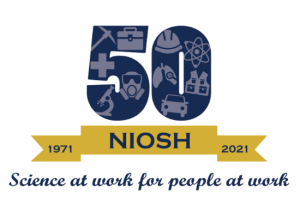Reducing Occupational Chronic Disease: CRC Cross Sector Program
Posted on byOver the course of NIOSH’s 50-year history, occupational chronic diseases, including cancer, cardiovascular disease, and adverse reproductive outcomes have always been a significant public health burden and source of economic costs. Since its inception in 2004, the Cancer, Reproductive, Cardiovascular, and Other Chronic Disease Prevention Program (CRC), within the NIOSH Program Portfolio, has provided leadership in the prevention of work-related chronic diseases and conditions. The CRC Program works with partners in industry, labor, trade associations, professional organizations, and academia focusing on preventing and reducing: (1) occupational cancer; (2) adverse reproductive outcomes related to workplace exposures; (3) cardiovascular disease among workers; and (4) other chronic diseases such as occupational neurologic and renal disease. Evidence of burden, need, and impact are used to identify priorities to help guide research  efforts towards preventing occupational disease.
efforts towards preventing occupational disease.
CRC Program projects have conducted etiologic and exposure assessment research in working populations, provided data for development of standards and recommendations for control of hazards, and communicated results to scientists, workers, and the public.
One example of the important CRC etiologic research in cardiovascular disease research is the Buffalo Cardio-Metabolic Occupational Police Stress Study. In this project, NIOSH researchers have an ongoing collaboration with the State University of New York at Buffalo to study the effects of policing and occupational stress on early (subclinical) markers of cardiovascular health. This is one of the first population-based studies to integrate psychological, physiological, and subclinical measures of psychosocial stress and disease.
CRC research plays an important role in standard-setting and guidance and has had a substantial impact on occupation-related carcinogen evaluations led by the International Agency for Research on Cancer (IARC) and the National Toxicology Program . Figure 1 illustrates the percent of IARC evaluations that cited CRC program work from 2012 to 2020. In 2019 and 2020 nearly 100 percent of the evaluations cited work form the CRC program.
It is important to communicate our research to scientists, workers, and the public. Much of the CRC reproductive research is posted on the NIOSH-Reproductive Health webpages. These webpages are among the most visited at NIOSH, increasing by 252% from 2017 to 2020. Topics covered include workplace hazards that can affect the ability to become pregnant, the health of unborn children, and child development.
Looking forward, the CRC Cross-Sector Program welcomes opportunities for collaboration in reducing the burden of occupational chronic disease, including in the following areas:
- Basic research to evaluate exposures to carcinogens in manufacturing, mining, and public service sectors
- Basic etiologic/intervention research to further understand how stress, shift work, and heat contribute to CVD
- Research to characterize the relationship between shift work and chronic disease
- Intervention studies to overcome barriers to PPE use, e.g., among nurses administering hazardous drugs
- Intervention/translation research to reduce chemical exposures to nail and hair salon workers
- Basic etiological studies to understand chemical exposures and adverse reproductive outcomes in manufacturing and service workers; and
- Surveillance and basic etiologic studies to identify patterns of chronic kidney disease in heat-related occupations (e.g., agriculture, construction).
- Basic research to further understand chemically-induced neurotoxicity and its contribution to major brain diseases.
Please contact crcprogram@cdc.gov if you are interested in collaborating in any of these areas.
Lastly, NIOSH CRC staff participate in and act as stewards of the National Occupational Research Agenda (NORA). In 2016, the NORA CRC Council was formed to bring together individuals and organizations to share information, form partnerships, and promote the adoption and dissemination of solutions for chronic diseases that work. The Council prioritizes research, understands the most effective intervention strategies, and works to implement those strategies to achieve sustained improvements in workplace practice. Several working groups are actively developing and implementing research-to-practice activities to protect workers with  critical exposure prevention and intervention strategies and information to reduce risks and overall burden of occupational chronic disease.
critical exposure prevention and intervention strategies and information to reduce risks and overall burden of occupational chronic disease.
This blog is also available in Spanish.
This blog is part of a series for the NIOSH 50th Anniversary. Stay up to date on how we’re celebrating NIOSH’s 50th Anniversary on our website.
Todd A. Stueckle, Ph.D., M.A., is a Research Biologist in the NIOSH Health Effects Laboratory Division.
Nicole S. Olgun, Ph.D., is a Toxicologist in the NIOSH Health Effects Laboratory Division.
Raquel Velazquez-Kronen, Ph.D., is an Epidemiologist in the NIOSH Division of Field Studies and Engineering.
Elizabeth Whelan, Ph.D., is a Branch Chief and Epidemiologist in the NIOSH Division of Field Studies and Engineering.
For More Information:
Websites
Cardiovascular Disease and Occupational Factors
Reproductive Health and The Workplace
CRC-Related NIOSH Science Blog Posts
Stress and Health in Law Enforcement
Recent News about Night Shift Work and Cancer: What Does it Mean for Workers?
Firefighter Cancer Rates: The Facts from NIOSH Research
World Cancer Day 2020 – Reflecting on a Decade of NIOSH Cancer Research
Can Workplace Exposures Increase Risks of Birth Defects? – Epidemiology in Action
NORA
The National Occupational Research Agenda
Celebrating 25 Years of the National Occupational Research Agenda
References
Charles LE, Zhao S, Fekedulegn D, Violanti JM, Andrew ME, Burchfiel CM [2016]. Shiftwork and decline in endothelial function among police officers. Am J Ind Med doi:10.1002/ajim.22611
Fekedulegn D, Burchfiel CM, Charles LE, Hartley TA, Andrew ME, Violanti JM [2016]. Shift work and sleep quality among urban police officers: The BCOPS Study. J Occup Environ Med 58(3): e66-e71.
Nevels TL, Burch JB, Wirth MD, Ginsberg JP, McLain AC, Andrew ME, Allison P, Fekedulegn D, Violanti JM (2021). Shift Work Adaptation Among Police Officers: The BCOPS Study, Chronobiology International, 38:6, 907-923, DOI: 10.1080/07420528.2021.1895824.,
Straif K [2008]. The burden of occupational cancer. Occupational and Environmental Medicine. 65(12):787-788.
Wirth MD, Andrew ME, Burchfiel CM, Burch JB, Fekedulegn D, Hartley TA, Charles LE, Violanti JM. Association of shiftwork and immune cells among police officers from the Buffalo Cardio-Metabolic Occupational Police Stress study. Chronobiol Int. 2017;34(6):721-731. doi: 10.1080/07420528.2017.1316732.
Posted on by

